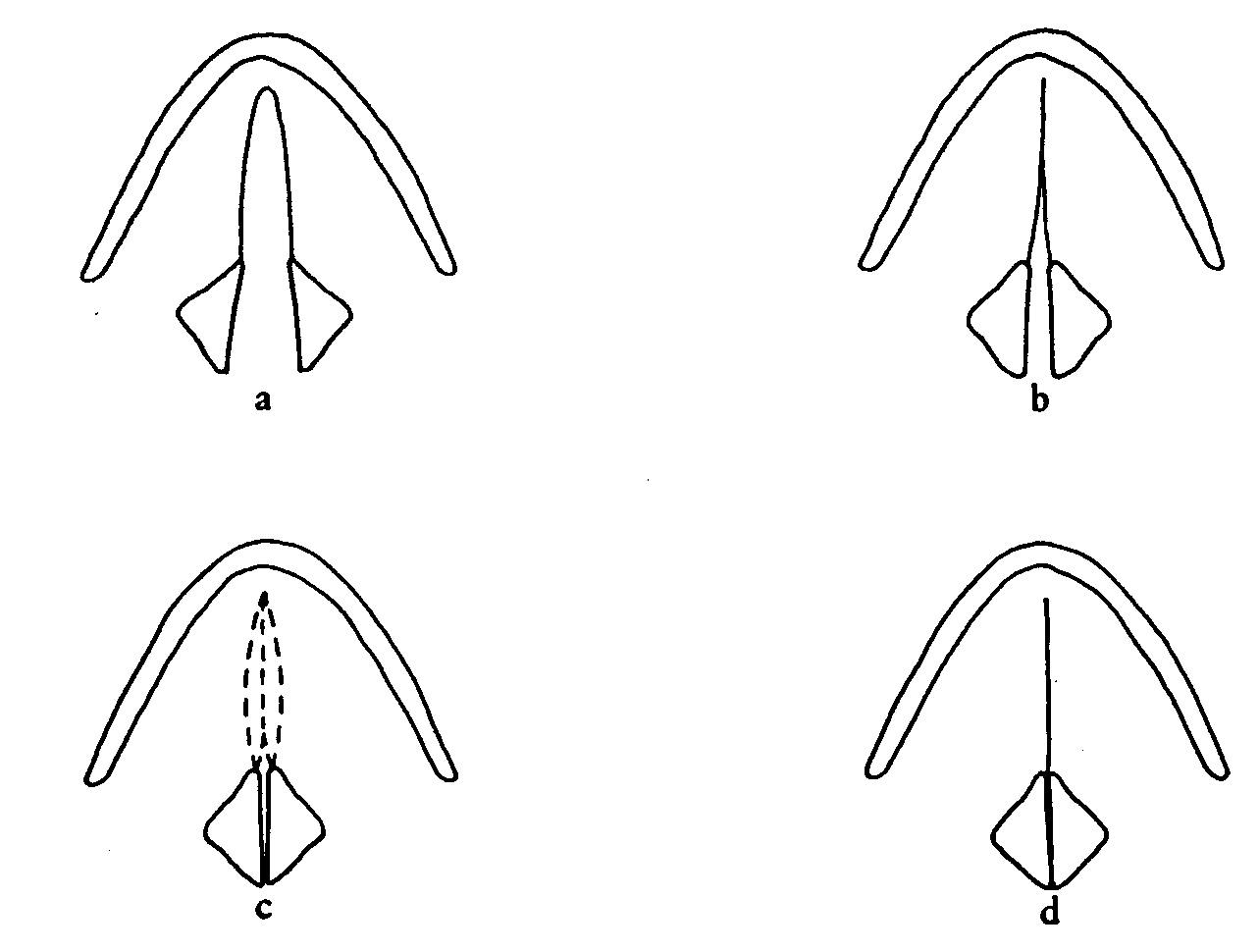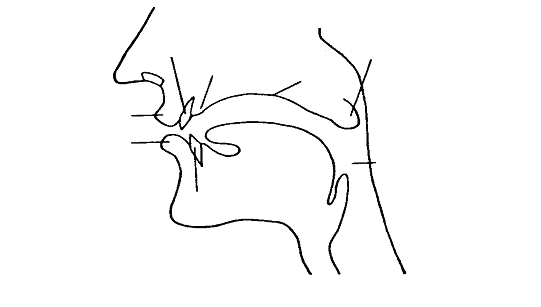
- •Contents
- •Введение
- •Формы контроля
- •Нормы оценки
- •Содержание курса «практическая фонетика английского языка»
- •1. Key words
- •2. Theoretical background
- •2.1 Organs of speech
- •2.2 Vowels and their classification
- •2.3 Consonants and their classification
- •Voiceless
- •2.4 Transcription
- •3. Self-check questions
- •4. English rhythm practice
- •Unit 2 friction consonants front and back vowels
- •1. Key words
- •2. Theoretical background
- •2.1 Friction consonants
- •2.2 Front and back vowels
- •3. Lab works
- •3.1 Lab work 2 English short vowels
- •3.2 Lab work 6 Fricatives and affricates
- •4. Self-check questions
- •5. English rhythm practice
- •1. Key words
- •2. Theoretical background
- •2.1 Stop consonants
- •2.2 Central vowels
- •2.3 Diphthongs and their classification
- •D iphthongs
- •2.4 Closing diphthongs
- •3. Lab works
- •3.1 Lab work 3 Long vowels
- •3.2 Lab work 4 Plosives
- •4. Self-check questions
- •5. English rhythm practice
- •Unit 4 nasal consonants centring diphthongs
- •1. Key words
- •2. Theoretical background
- •2.1 Nasal consonants
- •2.2 Centring diphthongs
- •3. Self-check questions
- •4. English rhythm practice
- •Unit 5 lateral consonant triphthongs
- •1. Key words
- •2. Theoretical background
- •2.1 Lateral consonant
- •2.2 Triphthongs
- •3. Lab works
- •3.1 Lab work 3 Diphthongs and triphthongs
- •3.2 Lab work 5 Revision
- •4. Self-check questions
- •5. English rhythm practice
- •Unit 6 gliding consonants
- •1. Key words
- •2. Theoretical background
- •2.1 Gliding consonants
- •3. Lab works
- •3.1 Lab work 7 Further consonants
- •4. Self-check questions
- •5. English rhythm practice
- •Unit 7 consonant clusters
- •1. Key words
- •2. Theoretical background
- •2.1 Initial consonant clusters
- •2.1.2 Combinations of alveolar consonants /t, d/ with /r/
- •2.1.3 Combinations of dental consonants /t, d/ with /r/
- •2.1.4 Combination of consonants with /w/
- •2.1.5 Sequences of three consonants initially
- •2.2 Final consonant clusters
- •2.2.8 Longer consonant sequences
- •3. Lab works
- •3.1 Lab work 8 Consonant clusters
- •4. Self-check questions
- •5. English rhythm practice
- •Unit 8 stress
- •1. Key words
- •2. Theoretical background
- •2.1 Word stress
- •2.2 Utterance stress
- •2.3 Weak and strong forms of words
- •3. Lab works
- •3.1 Lab work 9 Weak syllables
- •3.2 Lab work 10 Word stress
- •3.3 Lab work 11 Complex word stress
- •3.4 Lab work 12 Weak forms
- •3.5 Lab work 13 Revision
- •4. Additional exercises
- •5. Self-check questions
- •6. English rhythm practice
- •Unit 9 rhythm
- •1. Key words
- •2. Theoretical background
- •3. Self-check questions
- •4. English rhythm practice
- •Unit 10 fluency
- •1. Key words
- •2. Theoretical background
- •2.1 Linking
- •2.2 Changing word shapes
- •2.2.1 Alterations
- •2.2.2 Disappearances (elision)
- •3. Self-check questions
- •4. English rhythm practice
- •Unit 11
- •Intonation
- •1. Key words
- •2. Theoretical background
- •2.1 Intonation
- •2.2 Utterance and its structure
- •2.3 Tune shapes
- •2.3.1 The Glide-Down
- •2.3.2 The Glide-Up
- •2.3.3 The Take-Off
- •2.3.4 The Dive
- •2.4 Usage of the tunes
- •2.4.1 The usage of The Glide-Up
- •2.4.2 The usage of the Glide-Up
- •2.4.3 The usage of the Take-Off
- •2.4.4 The usage of the Dive
- •3. Lab works
- •3.1 Lab work 15 Tones
- •3.2 Lab work 17 Intonation
- •4. Additional exercises
- •5. Self-check questions
- •References:
1. Key words
lungs
wind-pipe
larynx
vocal cords
glottis
pharynx
mouth cavity
nasal cavity
alveolar ridge (teeth-ridge)
hard palate
soft palate
uvular
tongue
teeth
lips
vowel
cardinal vowels
consonant
phoneme
transcription
2. Theoretical background
2.1 Organs of speech
All speech sounds of English are made with some movement of air when it moves out of the lungs /lANz/. We draw it into the lungs quickly and we release it slowly. The air passes through the wind-pipe /'wInd paIp/ and comes to the larynx /'lxrINks/. The larynx has several very important functions in speech. It is situated in the neck. The front of the larynx comes to a point and you can feel this point at the front of your neck – particularly if you are a man and/or slim. This point is commonly called the Adam’s Apple. Inside the larynx there are the vocal cords /'vqVkql kLdz/ (vocal folds /fqVldz/). These are two thick bands of muscle (like elastic tissue) lying opposite each other across the air passage, rather like a pair of lips (see Figure 1). At the front the vocal cords are joined together. The opening between the vocal cords is called glottis /'glPtIs/. If the vocal cords are apart we say that the glottis is open; if they are pressed together we say that the glottis is closed. This seems quite simple, but in fact we produce a very complex range of changes in the vocal cords and their positions. These changes are often important in speech.
Figure 1. The vocal cords.

So, we distinguish 4 main positions of the vocal cords:
Wide apart (Fig. 1a)
The vocal cords are wide apart for normal breathing and usually for voiceless consonants.
Narrow glottis (Fig. 1b)
If air is passed through the glottis when it is narrowed, the result is a fricative sound [h].
Vibration (Fig. 1c)
When the edges of the vocal cords are touching each other, or nearly touching, air passing through the glottis will cause vibration. Air is pressed from the lungs and this air pushes the vocal cords apart for a moment so that a little air escapes. Then the vocal cords are brought together again. Then the air will force them apart again, and they will close again. This opening and closing happens very quickly (it may take place as many as 800 times per second) and is repeated regularly. If the vocal cords vibrate we will hear the sound that we call voice.
Tightly closed (Fig. 1d)
The vocal cords can be firmly pressed together so that air cannot pass between them. When this happens in speech we call it a glottal stop. The compression of the air may be very great and when the vocal cords are opened suddenly the air bursts out with a sort of coughing noise.
After passing through the larynx, the air goes to the pharynx /'fxrINks/. It is a tube which begins just above the larynx. It is about 7 cm long in women and about 8 cm in men, and at its top it is divided into two, one part being the back of the mouth cavity /'kxvItI/ and the other being the beginning of the nasal cavity (see Figure 2).
Figure 2. The articulators.

upper teeth hard soft palate (velum)
nose alveolar ridge palate
upper lip
tongue
lower lip
pharynx
lower teeth
larynx
The soft palate /sPft 'pxlqt/ can be touched by the tongue. It can move: it can be raised so that it touches the back wall of the pharynx and this stops the breath from going up into the nasal cavity and forces it to go into the mouth only. In its lowered position, the soft palate allows the breath to pass out through the nose. This is the normal position of the soft palate when we are not speaking but breathing quietly with our mouth closed. It ends in a point called the uvula /'jHvjVlq/.
The hard palate is often called the ‘roof of the mouth’. It is the highest part of the palate, between the soft palate and the alveolar ridge. You can feel its smooth curved surface with your tongue. It is fixed in its position.
The alveolar ridge /xl'vIqlq rIG/ (or the teethridge /'tJTrIG/) is between the top front teeth and the hard palate. You can feel its shape with your tongue. Its surface is rather rough and is covered with little ridges.
The tongue /tAN/ is, of course, the most important organ of speech and it can be moved into many different places and different shapes. It is usual to divide the tongue into several parts: tip, blade, front, back, sides. The back of the tongue lies under the soft palate when the tongue is at rest.; the front lies under the hard palate; the tip and the blade lie under the alveolar ridge, the tip being the most forward part of all and the blade between the tip and the front. The tip and the blade are very mobile. The front can be flat or it can be raised to the hard palate. The back of the tongue too can be flat or it can be raised to touch the soft palate. The sides of the tongue may be either curved upwards to meet the sides of the palate or left flat.
The teeth (upper and lower). The lower teeth are not important in speech except that if they are missing certain sounds will be difficult to make. But the upper front teeth are used in English to some extent.
The lips (upper and lower) are important in speech. They can take up different positions. They can be pressed together (when we produce sounds [p, b], brought into contact with the teeth (as in [f, v]), or rounded (for vowels like [H]).
